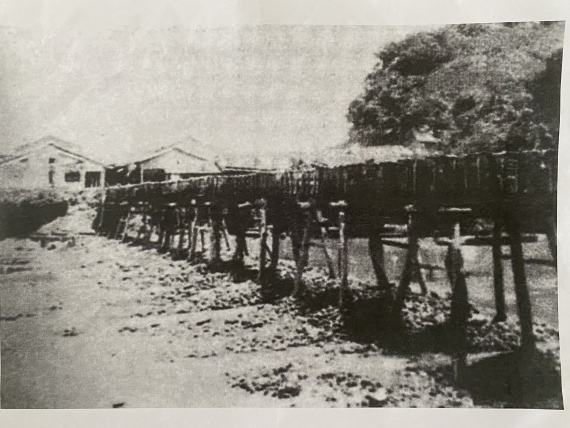Liugongjun and Wooden Trough Bridge
Since 1740 (the 5th year of the Qianlong era), Kuo Hsi-liu had dedicated himself to building irrigation canals for fields in Xinyi and Songshan of Taipei. He started with Shikong Tunnel but was not able to complete it. The tunnel’s construction would progress with the help of residents from five villages in Dapinling in 1753 and was completed in 1760 (the 25th year of the Qianlong Era), and it had since distributed water from Qingtan River. The most difficult part of the tunnel’s construction was bringing the water drawn from Qingtan River over the river’s currents to Wulixue River (nowadays Jingmei River). The entire river-water distribution facility was completed in 1761. The facility used a U-shaped bridge that was composed of wooden boards and supported by 47 wooden stakes embedded in a riverbed, and the bridge distributed water to Wulixui River. The bridge was called “Kingbue” (or the “Wooden Trough”). Today’s Jingmei Street, which lies at the end of then-bridge, was originally called “Kingbe” (the End of the Wooden Trough); the part of Zhongxing Road in Xindian that lies close to Jingmei River was called “Jingtou” (the Head of the Wooden Trough)”
The wooden trough bridge provided the only route through which residents traveled between local rivers. However, because the bridge was frequently damaged, it could not distribute water for irrigation. Kuo Hsi-liu solved this problem by using a water cylinder to drill openings at the bottom of the bridge, overlapping them, and embedding them in the riverbed to distribute water. But this improvement was offset by a flood during a typhoon in 1765, which Kuo felt depressed about even after his death in that year. Two years later (the 32nd year of the Qianlong era), Kuo’s son, Kuo Yuan-fen, inherited his father’s vocation, using V-shaped sharp-edged wooden troughs instead to deliver water while preventing pedestrian entry. Kuo’s irrigation canals could therefore distribute water to fields in eastern Taipei, just like it had done before. These canals are collectively known as the “Liugongjun canal system” to commemorate its architect, Kuo Hsi-liu.
By around 1800 (during the reign of Emperors Jiaqin and Daoguang of the Qing Dynasty), silt had accumulated at Duchuantou (Head of the Ferry Port) in Xizhikou of Jingmei, forcing ferries to dock near the wooden trough bridge and making Kingbeding Street (which spanned between Jingmei River and pork shops in Jingmei Public Market) a bustling place. The area beneath the bridge where ferries dock was called “Jianjiaotan.” The wooden trough bridge was the first bridge to have crossed Jingmei River, connecting the present-day Zhongxing Road in Xindian and Jingmei Street on the other side. It was merely used to distribute water; ferries were the only means to travel between both sides of Jingmei River.

最新自 何文賢 / He Wen-hsien
- 1960年代的景美菜市場
- 己亥年(108年)景美聯合遶境
- 壬辰年(民國101年)景美集應廟迎香慶典
- 壬辰年(民國101年)景美聯合遶境慶典
- 文山興安宮
- 古亭地政事務所
- 未有大樓前的景美街景
- 由景文街看車前路
- 車前路地貌的改變
- 辛卯年(民國100年)北投集應廟至景美迎回保儀
- 原車前路上順泰玩具食品行
- 高選風遺墨
- 景文街林鶴年醫院舊宅
- 景美集應廟豬公祭典(一)
- 景美舊橋封橋待拆除
- 開道碑重置揭幕
- 瑠公圳舊道與新道會合點
- 興隆市場
- 1970年以前景美的工廠及公營機構
- 1980年以後景美的工廠及公營機構
- Liugong Bridge: the First Reinforced-Concrete Bridge in Taiwan
- Expected Changes for the Landscape of Jingmei After 2020
- Landscape of Jingmei during 2000–2020
- Landscape of Jingmei during 1980–2000
- Landscape of Jingmei during 1960–1980
- Landscape of Jingmei before 1960
- The Stealthy Wansheng River
- Turning Jingmei River Channels into Parks
- A Potential Archeological Site of Shiwufen
- Xingfu Village Monument
- Earth God Temple in Jingmei
- History of Wan-Xin Railway
- History of Jingmei Bridge
- Coal Mining in Wenshan District
- Important Infrastructures in Wenshan District from the Past
- Changes in Jingmei’s Geography and Road Infrastructure
- History of Jingmei
- 霧裡薛圳圳路
- 景美街1號與2號距離遠
- 景美行政變遷
- 景美老街拱形騎樓元素
- 都更下的景美街困境
- 2000年至2020年景美地景變遷
- 1960年以前景美地景樣貌
- 1960年至1980年景美地景變遷
- 1980年至2000年景美地景變遷
- 2020年後景美地景變遷的期待
- 景美街商業土地使用分區
- 原貌仍在的泰興染織廠
- 中農化工廠基地變遷
- 1980年以後景美的工廠及公營機構
- 1970年以前景美的工廠及公營機構
- 興福庄「建塚記念碑」
- 金獎外觀興隆市場
- 臺北花木批發市場
- 疑似十五份遺址
- 會元洞清水祖師廟
- 景美福興宮
- 景美瑠公圳暨成巷道
- 景美忠勤三莊新面向
- 景美「賴氏萬壽塔」
- 頂公館福德宮
- 消失的興福庄浚溝修路石碑
- 和伯公紀念會館
- 台北江西會館及萬壽宮
- 在興隆路的台北畜產運銷公司
- 在景美的古亭地政事務所
- 文山興安宮
- 文山溪洲福德宮
- 三福街古道
- 十五分火車站
- 十五分庄舊地名
- 木柵集應廟保儀尊王巡境貓空
- 甲午年(103)木柵集應廟巡境慶典
- 景美集應廟豬公祭典
- 仙跡岩拾遺
- 仙跡岩的民間信仰
- 仙跡岩舊八景
- 龍吃水的地理景觀
- 圳後山的圖根點
- 景美山的三角點
- 百年金龜樹生病了
- 景美其他的老樹
- 景行公園的老樹
- 景美養工處老樹
- 巷內的魯花樹
- 興安宮的老榕樹
- 景豐街的老樹
- 萬有公園的老樹
- 萬和公園的老樹
- 景美國中的老樹
- 景美國小附近老樹
- 景美國小的老樹
- 萬新鐵路的歷史
- 景美聖方濟沙勿略堂
- 景美的西方教會彙總
- 味自慢居酒屋
- 義興樓食堂
- 景美的春燕
- 萬盛溪舊溪床旁的春燕


